Nuggets of News Blog
|  |
Saturday, November 19 2022
If you’re used to water mining, having success in the desert might seem challenging— that is until you start thinking of desert ground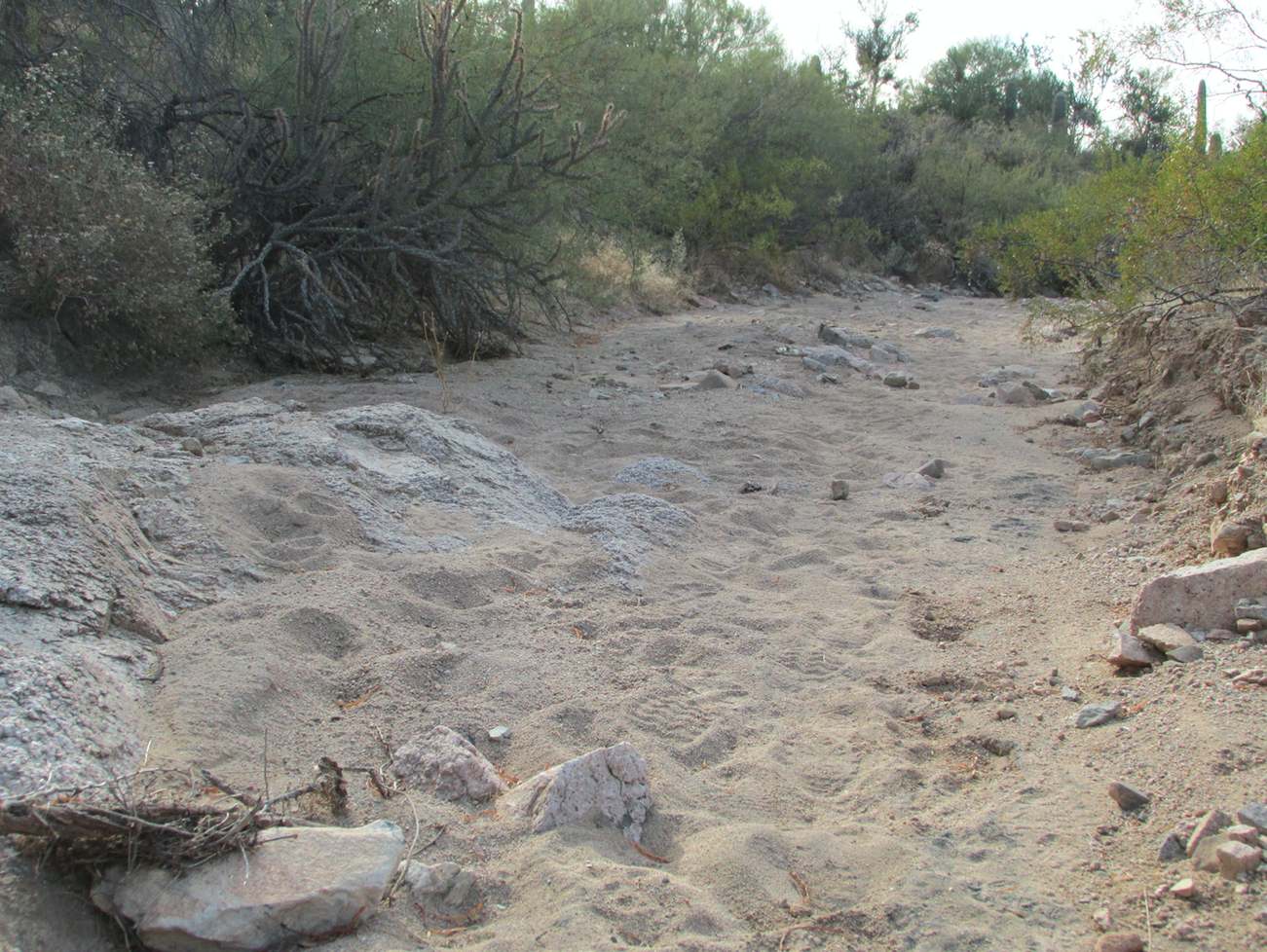 as a massive sluice box. Many of the principles you’re used to when prospecting and mining in waterways, will translate into desert mining. The most important thing to remember is that water is crucial to gold movement. Unlike a running river or creek with highs and lows, desert placers are much different in that gold is moved quickly during a flash flood, leaving gold stranded as opposed to being moved further by continual water flow in a creek. as a massive sluice box. Many of the principles you’re used to when prospecting and mining in waterways, will translate into desert mining. The most important thing to remember is that water is crucial to gold movement. Unlike a running river or creek with highs and lows, desert placers are much different in that gold is moved quickly during a flash flood, leaving gold stranded as opposed to being moved further by continual water flow in a creek.
During a river high-water event in a non-arid area, gold is moved over a larger area by massive water flows that continue until the water slows as the source dissipates its energy. Spring snow runoff is a good example. Rivers rise and sometimes flood based on the upstream water source. When the snow has melted, the river will slowly get back to normal. In the desert, gold is moved in the exact same way with the exception that water powerful enough to move gold does so and then just simply stops. In a flash flood, gold is moved very violently and often a very short distance, sometimes percolating into valuable pockets. Here’s where the difference between water and desert mining principles comes into play generally flood gold will concentrate in areas that do not meet the standard thought of inside bends and where the water flow becomes lower.
For the most part, desert mining experts recommend staying out of the washes, gulches and dry river beds— that is unless you clearly see exposed bedrock. Gold will settle fairly quickly when it is trapped behind jagged bedrock and small fault lifts that have not been worn down over time by constant water flow. It IS true you can find areas of concentrated gold-bearing material in the washes, however, the amount of time and energy to get through feet of overburden is usually just not worth it, especially when there are higher values to be found outside of the wash.
Follow the leads out of the wash to where the gold lives in higher concentration. Test and sample areas you see with a great deal of runoff from a tributary coming into the main wash. Here you are only digging through the current flood layer and testing for flood gold. Make your way out of the wash carefully looking at the bottom of the tributary and the areas where the water flowed into the tributary. Look closely for jagged bedrock and slight lifts in the ground and then prospect. Continue to test each of those spots. What started as a few specks of flood gold in the main wash can lead to larger and larger deposits on the flats or in slight inclines across the desert floor. Keep in mind that when a flash flood is dissipating, there is not enough energy to move a lot of rock, but the sand will continue to flow a bit, creating great clues.
In general, cool season precipitation (October through April) is the most extensive source of rain in the desert regions. Rainfall is more widespread and of relatively long duration during the cool season. On the other hand, warm season precipitation (May through September) results largely from short monsoon-type thunderstorms.
If you’re ready to head to a sunnier climate this winter, keep these tips in mind and you just might find enough similarities between water and desert mining to make you return every year. Good luck!
Friday, December 29 2017
Given a choice, most miners prefer using water to wash and run material, but in some dry, remote areas that 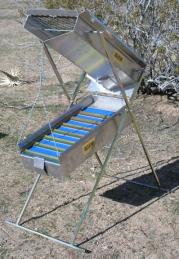 is just not feasible. If you focus on the natural conditions that exist in desert regions and work with them, you can maximize fine gold recovery. The number one rule is that the drier the soil, the better. Damp soil conditions are very much a hindrance for drywashers. Beyond that, learning the different soil types you may encounter in the desert and how to deal with them can increase your gold recovery. is just not feasible. If you focus on the natural conditions that exist in desert regions and work with them, you can maximize fine gold recovery. The number one rule is that the drier the soil, the better. Damp soil conditions are very much a hindrance for drywashers. Beyond that, learning the different soil types you may encounter in the desert and how to deal with them can increase your gold recovery.
Clay is generally known as a great gold robber, making clay-bound gravels the biggest difficulty to overcome. In most of the placers directly derived from weathering lode deposits, the placers are in ravines, gullies and hillsides with sometimes very little gravels and mostly decomposed fragment of rock and fine silt from the decomposing host rock. Host rock containing a lot of feldspars are most problematic. As feldspar breaks down, it creates some difficult clays and silts that bind fine gold to small rocks and sand with the clay and silt particles forming larger clods.
Loamy or sandy conditions are much easier to process with a drywasher than clay-bound material due to the absence of clods and clumps. But if dirt clods are giving you grief, break them down with a large hammer on a canvas tarp, or use a mortar and pestle (dolly pot).
Once you are set up to run material, process in short runs before cleaning out the riffle tray (perhaps after every three 5-gallon buckets). Frequent clean ups minimize the amount of fine gold that may creep or walk down the riffle tray with the tailings. This method uses your dry washer as a form of a classifier to screen off larger material while getting rid of much of the fine silt and lighter weight material.
Re-running tailings can aid in the recovery of lost gold— especially small gold dust and flakes. The second pass through is usually much quicker than the first time because the material has already been classified. With some placers, especially flat, fine gold, rerunning material can be very lucrative. In places where gold is more coarse and angular, very little gold will like be recovered by running the tailings a second time.
You may want to experiment with adding a second layer of cloth to a portion of the riffle tray. Doing so reduces airflow by almost half in that section. In addition to the riffle tray, the void under the riffle tray can collect a sizable amount of really fine gold mixed in with fine silt.
No doubt there are going to be losses of gold when using a drywasher to recover fine gold (20 minus mesh down into the 200 minus gold), but the end goal should be to limit those losses as much as possible and these tips should help. Good luck! Learn more about Gold Buddy drywashers here.
Nugget of News Blog
Tuesday, December 01 2015
With the weather turning colder, you might think you're done prospecting 'til next summer, but you don't have to be! Even if you're not a regular snowbird heading to a warmer climate for the next few months,  you can take a short desert vacation some time this coming winter, and turn it into a lucrative gold prospecting trip, too. you can take a short desert vacation some time this coming winter, and turn it into a lucrative gold prospecting trip, too.
Gold mining in the desert is especially enjoyable if you're not into crowds— the desert can be delightfully smog free and people free in the winter. Experts say there is just as much gold waiting to be taken out of the desert as there is commonly found in streams and rivers. Why? Well, throughout history the desert mines just never got the publicity that wet places like California's Mother Lode did, so fewer prospectors went there. Plus, back in the day, mining used to be harder in dry conditions. Luckily that's no longer true if you have the right equipment.
• If you're used to highbanking in the summer, give drywashing a try this winter. Old-timers used the wind to separate their gold from the sand by tossing the gravel up in the air and catching it in a blanket. The gold, being heavier, fell in the blanket, while the wind blew away the sand. Using a modern portable drywasher is a lot easier!
• Metal detecting is another great way to hunt for gold in the desert. Gold detectors are not necessarily higher in cost, but they are built with a higher sensitivity to detecting gold nuggets, and have better ground balancing and
discrimination abilities.
• A bonus of prospecting in the desert is the abundance of interesting rocks. You can find many unusual rocks and semi-precious gems such as tourmaline, turquoise, agate, jasper, and more. Lapidary shops can cut and polish the rocks for you, or buy your own rock tumbler and lapidary tools and learn a new hobby.
This winter, consider extending your gold-getting season with a prospecting trip to a sunnier, warmer state. Good luck and have fun!
Saturday, March 01 2014
 Some say that "gold is where you find it" and while that may be true, once you arrive at a known gold-bearing location, how do you decide where to dig first? Successful prospectors follow different methods, so there is no single "right" way, but no matter if you are sluicing, dry washing, or metal detecting, if you first consider the "lay of the land" you can better pinpoint a place to start. Some say that "gold is where you find it" and while that may be true, once you arrive at a known gold-bearing location, how do you decide where to dig first? Successful prospectors follow different methods, so there is no single "right" way, but no matter if you are sluicing, dry washing, or metal detecting, if you first consider the "lay of the land" you can better pinpoint a place to start.
Natural Factors to Consider Before Digging for Gold:
- Types of Placer Deposits. Alluvial, residual, beach, and other types of placer gold are all worked differently. Alluvial gold forms in streams. The gold tends to concentrate on bedrock as it moves downstream and makes its way down through the gravel to bedrock. Residual placers form on the surface as rock materials weather and are washed or blown away and do not concentrate on bedrock. Knowing the type of placer makes a big difference as to where you should begin to look for it.
- Quartz Veins. Gold often forms with quartz, so quartz veining can be a very positive sign. Quartz is very resistant to weathering, so it may hang around on the surface long after any nuggets have sunk below the soil. If you find a visible quartz vein outcrop, that can be a good sign. The outcrop, as well as any areas downhill from it, should be sampled. Also remember that not all vein quartz is white. Some can be stained red-brown from iron.
- Iron Staining. Not all gold-bearing mineral deposits contain quartz. Gold-bearing veins can consist of calcite or mostly sulfides which often weather into iron-stained spots as the pyrites convert to iron oxides. While quartz is often a good indicator, it is not necessary for the formation of gold nuggets— but sulfur is necessary. In places where gold occurs with quartz, there is often a lot of iron, which was once (before it was oxidized) a sulfide such as pyrite. Any gold that was formed in these deposits is left in the red soils that remain, or perhaps nearby. The red soils can be deep orange or red-brown or brick red.
- Favorable Rocks. The type of rock considered "favorable" will vary greatly based on the area. The same "favorable" rock in California may not be the same "favorable" rock for finding gold in Alaska. In some places the best rock to look for might be schist or slate, in other places it might be volcanic. In general, sedimentary rock is usually not a favorable host rock for gold.
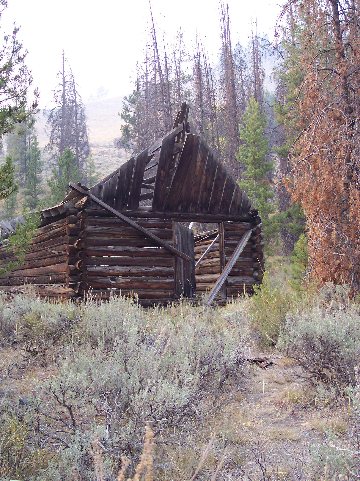 Man-Made Factors to Consider Before Digging for Gold: Man-Made Factors to Consider Before Digging for Gold:
The sites of small, old-time mining operations can be some of the best places to look for gold. After all, the old-timers didn't have the modern-day equipment that you have, so they left a lot behind. Depending on their age, these sites from yesteryear can be overgrown, but if you look for these indicators they will help you consider where to dig first:
- Ground Cuts. These are narrow trenches in the ground that carried the gravels to the sluice box.
- Rock Piles. Sometimes old-timers encountered rocks that were too large to pass through their sluices under the water pressure they had to work with, so bigger rocks were picked out by hand and tossed aside. Piles of rocks make an easy marker. Any quartz you find in rock piles should be checked with a metal detector— you might find a gold-quartz specimen that's worth a pretty penny. Rock piles can be visible in the desert as well. Although the old-timers were not sluicing in the desert, they used dry washers that had to be screened for coarse rocks. If you see a series of short rock piles a few feet in diameter that cover an area that seems to have been dug out, you can reasonably assume you have found an old dry wash site.
- Hydraulic Mine Workings. A sign that an area has been worked by hydraulic mining are the steep banks left behind when the gold ran out (or so they thought). These sites are also commonly marked by piles of big stacked rocks.
- Shafts. Miners sometimes dug deep shafts or adits to access gold veins. These working are usually easy to spot even today. If the dumps consist of rounded gravels, it is most likely from underground placer diggings. If the dumps contain angular broken rock, that would indicate blasting from lode mining.
Deciding where to dig first comes from knowledge. You get that knowledge from reading books and magazines dedicated to prospecting and metal detecting, talking with experienced old-timers, and GETTING OUT IN THE FIELD. Evaluate the area, think about the geology, and then make a plan before you dig. You may not always hit upon a promising location by considering the factors listed above, but your chances for success greatly increase. Be flexible, keep sampling, and try again if you don't have any luck at first. Spending a little time evaluating an area can lead to a much more productive hunt, because after all, "gold is where you find it."
Sunday, December 01 2013
Dry washers are like highbankers except they do not use water to recover gold. While wet processing is nearly always faster and more efficient, especially for fine gold, dry washers are the best tool for recovering gold nuggets, pickers, and flakes from dry materials in the desert or other areas where water is not plentiful.
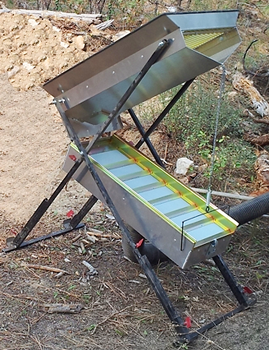 Drywashers are operated by shoveling gold-bearing gravels into an upper box which is covered with a screen. The larger rocks that are too big to pass through the screen slide off. Gravel small enough to go through is fed down into the lower gold recovery box, which is an inclined trough with cross riffles much like a sluice. The bottom of the recovery box consists of a thin, light-weight porous cloth. Beneath the riffle box is a blower that pulses air up through the cloth. The vibrations and air flow, combined with the shaking and classifying action of the dry washer allows the gold to settle to the bottom where it is captured in the riffles. Drywashers are operated by shoveling gold-bearing gravels into an upper box which is covered with a screen. The larger rocks that are too big to pass through the screen slide off. Gravel small enough to go through is fed down into the lower gold recovery box, which is an inclined trough with cross riffles much like a sluice. The bottom of the recovery box consists of a thin, light-weight porous cloth. Beneath the riffle box is a blower that pulses air up through the cloth. The vibrations and air flow, combined with the shaking and classifying action of the dry washer allows the gold to settle to the bottom where it is captured in the riffles.
Keep these tips and tricks in mind when using a dry washer:
• Moist soils and clay cause problems, so be sure to crush lumps of clay and dry your dirt in the sun (plastic tarps are ideal) before running through your dry washer. Surface soils might seem dry, but if you dig down a few inches, you may find moisture in the soil that will cause your sand, gravel, and gold to stick together.
• Double-check all the "throw away" rocks. Scanning them with a metal detector is a great way to ensure you're not tossing aside gold-laden rocks. Also, don't assume old tailings piles have been totally worked out. This is another time to use a metal detector because ordinary rocks could be laced with gold and completely over-looked by earlier prospectors.
• Consider using a dry gold vacuum to clean out crevices in bedrock. Feed the material that you sucked up into your vacuum bucket into your dry washer.
• Drywashing can be a very dusty process, so try to stay upwind as much as possible and wear a dust mask.
• Do a clean up every couple of hours, or after processing roughly one to two yards of material.
Looking for a drywasher? The Gold Buddy brand is available in 4 sizes and also check out the new heavy duty
Gold Storm dry washer. Whichever you choose, SAVE $10 with coupon code TAKETEN at check out. Offer expires Dec. 31, 2103.
Monday, November 05 2012
Drywashers are like highbankers, but they do not use water, making them excellent tools for recovering gold from dry material in desert areas. A dry washer is basically designed to be a waterless sluice. It separates gold from sand and other waste material with pulsations of air, vibrations, and static electricity instead of running water.
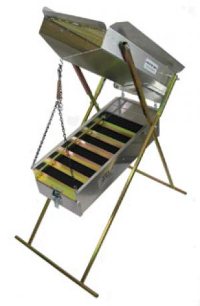 The top portion of a drywasher is called a hopper and consists of a box covered with wire screen. The screen is called a "grizzly." Dry gold-bearing material is fed onto the grizzly, which is mounted at a fairly steep angle. Thinner material, such as dirt and small gravel, falls through the grizzly screen and into the hopper. Larger material, such as rocks and sticks, roll off the grizzly and back onto the ground. Material from the hopper is then fed by gravity into the riffle tray below (looks like a sluice box), through an opening in the bottom of the hopper.
The under side of the riffle tray consists of a piece of stretched cloth that allows air to pass through the bottom of the riffle tray. A fan is mounted inside the sluice box and spins as air is blown up through holes in the bottom, usually by a leaf blower or another source of compressed air. Mounted on the fan is a weight that throws the fan off balance when spinning, and vibrates the entire box. This additional vibration assists in forcing flour gold to the bottom to be trapped, whereas lighter material is blown off.
Keep the following tips in mind, and you just might see the results of your drywashing efforts pay off even better:
• Moist soils and clay cause problems, so be sure to crush lumps of clay and dry your dirt in the sun (plastic tarps are ideal) before running through your dry washer. Surface soils might seem dry, but if you dig down a few inches, you may find moisture in the soil that will cause your sand, gravel, and gold to stick together.
• Double-check all the "throw away" rocks that get stuck in the grizzly before discarding. Scanning them with a metal detector is a great way to ensure you're not tossing aside gold-laden rocks. Another time to use your detector is on old tailings piles. These ordinary looking rocks could be laced with gold, yet were completely over-looked by earlier prospectors.
• Don't limited yourself to drywashing in "proven" areas. Because of the high costs associated with inaccessibility and lack of water, most desert regions have gone largely untouched by mining operations of yesteryear. A side benefit is that you don't have to go far off the beaten path. Virgin ground can be found in washes right off major roadways.
• Keep an eye on the terrain. Areas where the greatest amount of erosion has occurred are usually the areas where the highest concentration of gold values might be found.
• One of the best locations to look for gold is where the hills meet the desert and fan out. This is where flood waters from storms drop gold in the gullies and washes. There also may be more gold traps further up on hillsides. All it takes is one good storm to change the face of a desert landscape, so drywashing after a storm can potentially uncover previously hidden gold!
Gold Buddy drywashers are made in the USA and available in four sizes— Colt, Pony, Maverick, and Stallion. Each drywasher comes with a FREE "Working the Drywasher" instructional DVD, FREE shipping in most cases, and has a 5-year manufacturer's warranty.
|







 as a massive sluice box. Many of the principles you’re used to when prospecting and mining in waterways, will translate into desert mining. The most important thing to remember is that water is crucial to gold movement. Unlike a running river or creek with highs and lows, desert placers are much different in that gold is moved quickly during a flash flood, leaving gold stranded as opposed to being moved further by continual water flow in a creek.
as a massive sluice box. Many of the principles you’re used to when prospecting and mining in waterways, will translate into desert mining. The most important thing to remember is that water is crucial to gold movement. Unlike a running river or creek with highs and lows, desert placers are much different in that gold is moved quickly during a flash flood, leaving gold stranded as opposed to being moved further by continual water flow in a creek.

 Drywashers are operated by shoveling gold-bearing gravels into an upper box which is covered with a screen. The larger rocks that are too big to pass through the screen slide off. Gravel small enough to go through is fed down into the lower gold recovery box, which is an inclined trough with cross riffles much like a sluice. The bottom of the recovery box consists of a thin, light-weight porous cloth. Beneath the riffle box is a blower that pulses air up through the cloth. The vibrations and air flow, combined with the shaking and classifying action of the dry washer allows the gold to settle to the bottom where it is captured in the riffles.
Drywashers are operated by shoveling gold-bearing gravels into an upper box which is covered with a screen. The larger rocks that are too big to pass through the screen slide off. Gravel small enough to go through is fed down into the lower gold recovery box, which is an inclined trough with cross riffles much like a sluice. The bottom of the recovery box consists of a thin, light-weight porous cloth. Beneath the riffle box is a blower that pulses air up through the cloth. The vibrations and air flow, combined with the shaking and classifying action of the dry washer allows the gold to settle to the bottom where it is captured in the riffles.